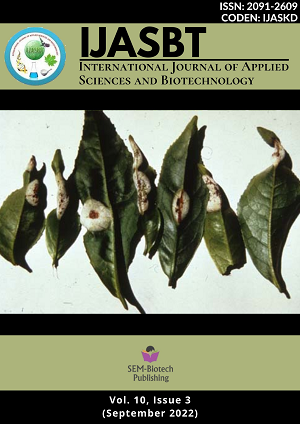Evaluation of Heavy Metals in Vegetables from Contaminated Agricultural Soils of Madhyapur Thimi, Bhaktapur District, Nepal and their Potential Health Risk Assessment
DOI:
https://doi.org/10.3126/ijasbt.v10i3.48703Keywords:
Agricultural soils, Bhaktapur district, Cancer risk, Heavy metals, VegetablesAbstract
The present study aimed to determine Cd, Cr, Cu, Pb, and Zn concentrations using flame atomic absorption spectrophotometer (FAAS) in five vegetables viz., Coriander (Coriandrum sativum), Mustard (Brassica campestris), Radish (Raphanus sativus), Spinach (Spinacea oleracea) and Chinese spinach (Amaranthus dubius), and their growing soils in three agricultural sites (Manohara, Bode, and Nagadesh) of Madhyapur Thimi, Bhaktapur district and to assess health risks using USEPA deterministic approaches. The average concentrations of HMs in soils were 0.85, 30.65, 40.06, 47.42, and 129.55 mg/kg for Cd, Cr, Cu, Pb, and Zn respectively, exceeding the normal soil quality standards except Cr. Similarly, the average concentrations of HMs in vegetables were 0.42, 6.63, 22.33, 1.34, and 77.16 mg/kg for Cd, Cr, Cu, Pb, and Zn respectively exceeding joint FAO/WHO standards except for Cu. The I-geo values revealed a class of unpolluted to moderately polluted levels for the agricultural soils indicating the 1st degree of soil pollution. Among the vegetables, Chinese spinach measured considerably high transfer factor (TF) for Cd (0.79), Cr (0.34), Cu (0.76), Pb (0.04), and Zn (0.89) indicating health concerns to the consumers. The hazard index (HI) for these HMs was found less than the acceptable limit (1.0) indicating no non-carcinogenic risk to adults through vegetable consumption. However, the lifetime carcinogenic risk (LCR) parameter indicated low to high cancer risk for Cd, Cr, and Pb. Among the vegetables, Chinese spinach estimated the highest LCR values for the HMs suggesting regular monitoring of HMs in soil and vegetable on account of their toxic effects.
Downloads
Downloads
Published
How to Cite
Issue
Section
License
Copyright (c) 2022 International Journal of Applied Sciences and Biotechnology

This work is licensed under a Creative Commons Attribution-NonCommercial 4.0 International License.




